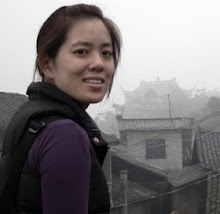Now that I've lived in a variety of condos, service apartments, luxury retreats, and one-star hotels in Shanghai, I can confidently offer a recommendation for the place to stay:
Rayfont Shanghai Xuhui Hotel, 瑞峰酒店, 7 Zhaojiabang Road (Ruijin Road), 8621-54077000. As the sign says so plainly, this is not a place for celebrities. It's a place for normal people, you know, celeberities.

If you want to experience the delights of traveling abroad that come with, say, design details by a hot New York hotelier, mildewed curtains framing a view of the Bund, or midnight calls from ladies offering massages, try any number of already discovered hotels listed in the guidebooks. If you want an exceptionally soft, clean bed, in-room Internet that works, rooms without the taint of smoke, and decent water pressure, come here.
Rayfont has two other locations in the city, but this one is the newest and in the relatively low-key, southwest corner of the French Concession, in an area that was once the stomping grounds of an organized crime family. If that's not enough, the rooms all have flat screen TVs and delicate ceiling lights made of string.

I recommend booking a suite, as they are designed for long-term stays but are offered at prices ranging from Y480 to Y660 a night. The family suite has two bedrooms, a living room, and kitchen with full-sized refrigerator, stove, and washing machine. You can rent dishes and cookware for Y30 a day, so you can run to the corner market and cook up some crab, which is infinitely more luxurious than a mint.
























 If you want to experience the delights of traveling abroad that come with, say, design details by a hot New York hotelier, mildewed curtains framing a view of the Bund, or midnight calls from ladies offering massages, try any number of already discovered hotels listed in the guidebooks. If you want an exceptionally soft, clean bed, in-room Internet that works, rooms without the taint of smoke, and decent water pressure, come here.
If you want to experience the delights of traveling abroad that come with, say, design details by a hot New York hotelier, mildewed curtains framing a view of the Bund, or midnight calls from ladies offering massages, try any number of already discovered hotels listed in the guidebooks. If you want an exceptionally soft, clean bed, in-room Internet that works, rooms without the taint of smoke, and decent water pressure, come here. I recommend booking a suite, as they are designed for long-term stays but are offered at prices ranging from Y480 to Y660 a night. The family suite has two bedrooms, a living room, and kitchen with full-sized refrigerator, stove, and washing machine. You can rent dishes and cookware for Y30 a day, so you can run to the corner market and cook up some crab, which is infinitely more luxurious than a mint.
I recommend booking a suite, as they are designed for long-term stays but are offered at prices ranging from Y480 to Y660 a night. The family suite has two bedrooms, a living room, and kitchen with full-sized refrigerator, stove, and washing machine. You can rent dishes and cookware for Y30 a day, so you can run to the corner market and cook up some crab, which is infinitely more luxurious than a mint.










